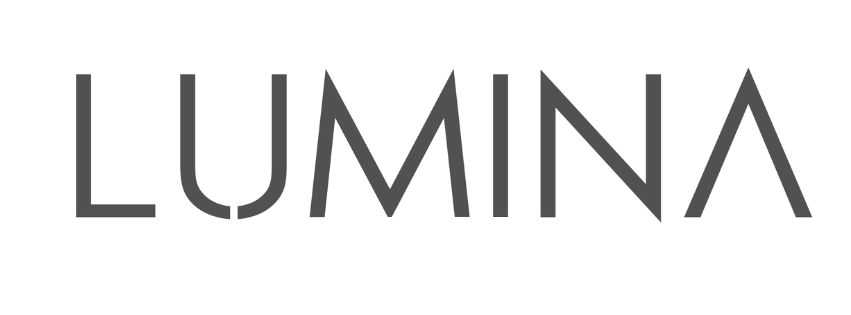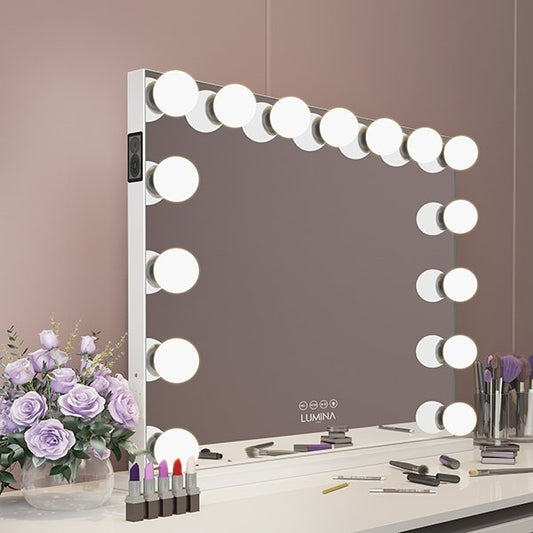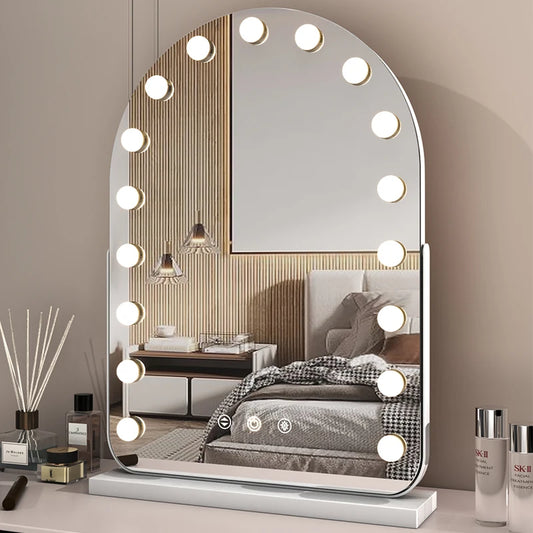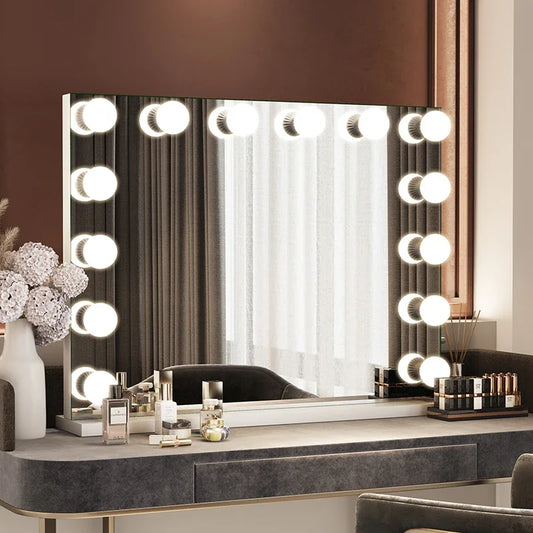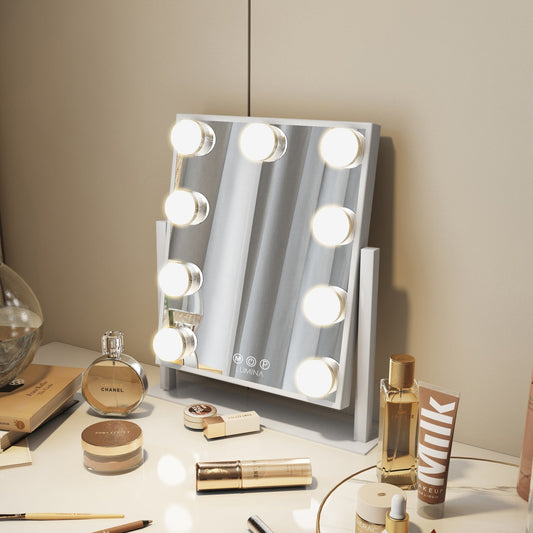If you’ve ever seen a dressing room in a professional theatre, you’ve probably seen how well-lit they are! Those high-intensity bulbs are meant to replicate the stage lights so that performers can apply the right amount of rouge, lipstick, etc.
Even if you’re not going to perform under super-bright lighting, the same principle applies for your makeup. Poor lighting can make you underestimate the amount of colour you need. Certain lights, including incandescent/tungsten bulbs, produce an orangish glow that can throw off your design.
Want to see what lighting products professionals use? Click here.
That’s why anyone serious about makeup needs proper lighting. No need to install a bunch of light sockets. Modern makeup lighting can be tweaked for any situation, whether you’re getting ready to take the stage or spending your evening in a dim nightclub. Read on to learn how to choose the best lighting for your makeup application.
What kind of lighting is best for applying makeup?
The best lighting for applying makeup has the right intensity, color, and direction. An intensity of 1000-1400 lumens, a color temperature of 4800-5000 kelvins mimicking natural daylight, and lighting from the sides to reduce shadows is recommended.
Before we dive into types of light fixtures and their specifications, let’s review what makes for good makeup lighting. You obviously want sufficient lighting to be able to see your face, but there are a few other factors as well. They are: intensity, colour, and direction.
Want to avoid all the fuss and get the best lighting for your makeup? Try our Hollywood Lighted Vanity mirrors!
Intensity
Those theatre dressing rooms are designed to mimic the brightness of stage lights, which are typically high-wattage tungsten lamps. However, those lights produce a lot of heat, as any actor or dancer will tell you. If your vanity has regular incandescent bulbs, you might end up sweating and squinting a lot — not ideal for perfectly applying your makeup!
Most people will not be in a situation with such bright lights. So, if you apply makeup in an overly bright place, you’ll likely make your blush, eye colour, and lipstick too intense. Ideally, you have just enough illumination to see your skin and makeup hues clearly.
How many lumens do you need for makeup lighting?
Professional makeup artists recommend lighting with 1000-1400 lumens for applying makeup.
First, know how to identify brightness. Wattage is the amount of electricity that a bulb uses; its actual luminosity is measured in lumens. Even a low-wattage LED bulb can produce brilliant light.
Professional MUAs recommend doing makeup with a light source of 1000 to 1400 lumens. This is the luminosity you would get from 75-100W incandescent bulbs, but without the warm, orange hue. Read on to learn how colour impacts your lighting for makeup application.
Also read: How to Choose the Best Light for Makeup Application
Colour
You know that the right colour is crucial to your overall makeup design. However, your products’ colours are impacted by the lighting. Let’s review some basic colour theory: there is a colour wheel with all colours of the rainbow. Colours that are opposite on the colour wheel cancel each other out. That’s why “colour-correcting” concealer is often yellow or green, so that it can reduce purplish or reddish areas of your face.
Recommended Read: What Color Light Is Best for Makeup Application?

By the same token, lighting can alter the appearance of your makeup. Your carefully applied purple eyeshadow can be essentially washed out by yellowish lighting (which is what incandescent lamps produce), while red lipstick may look dull under greenish lighting (such as fluorescent bulbs).
Colours that are next to each other on the colour wheel tend to enhance each other. Professional MUAs use this principle to create harmonious designs.
For example, this is why blue and green look so nice together. The same is true in lighting. A blueish hue can make green eyeshadow look more intense, while red lighting keeps yellows and golds looking vibrant.
Theatre lighting is typically “gelled,” meaning they have a coloured film over the fixture. Otherwise, all the performers would have a slight yellow or orange glow, because that’s what tungsten light produces.
So, if you’re trying to use tungsten bulbs for makeup, you’ll end up trying to counteract that hue — which can cause you to accidentally apply a makeup colour that doesn’t look good under other lighting.
What colour temperature do you need for makeup lighting?
For makeup application, use a light fixture with a color temperature between 4800 and 5000 kelvins to mimic natural daylight.
Colour temperature refers to the overall warmth or coolness of a light source. This impacts how you perceive the colours of your face and makeup, so it’s important to get it right. Colour temperature is measured in a unit called kelvins.
The lower the kelvins, the weaker the light and the warmer it appears to be. For example, a light with 1,000 kelvins is basically candlelight. It casts an orangish glow. Tungsten aka incandescent bulbs have a low/warm colour temperature. This is relaxing and cozy but not ideal for makeup design!

For makeup application, aim for a fixture with between 4800 and 5000 kelvins. This mimics natural daylight, which helps bring out colours’ true hues, yet it’s not as intense as direct sun, which can wash you out.
Direction
Whether you’re going to a nightclub, your workplace, or somewhere outdoors, you’ll most likely be in a place with ambient illumination.
This is quite different from your vanity, where the light usually comes from one direction. If your makeup lighting isn’t set up properly, this could be an issue.
For example, most bathroom vanities have the lights above your head. This casts a downward shadow that can make your makeup application difficult. You need illumination on the sides of your face, which is why those dressing rooms usually have lights all around the mirror. This is ideal for reducing shadows.
Natural sunlight at noon is the best light for makeup application, but a soft to bright white LED is the best artificial light.
You want the perfect mixture of brightness, color, and temperature. Look for a white light source with 1000 to 1400 lumens, that has a color temperature between 4800 and 5000 Kelvin, and is as close to 100 on the Color Rendering Index (CRI) as possible.
We’ll go over all of this in detail in this article.
When you have the best lighting, it can dramatically improve your makeup application and help you look your best, giving you the confidence you need to take on the day.
Understanding what good lighting is, and how artificial lighting holds up to natural light, can help you make wise decisions when purchasing lights for your hair and makeup.
Let's dive into what makes the best lighting for makeup application.
The Science Behind Lighting

The perfect lighting plays a major role in getting camera-ready. Here are some things to consider when choosing the best lighting for makeup application.
Electromagnetic Radiation
Electromagnetic radiation is made up of waves of the electromagnetic field that transmit through space. These wavelengths carry electromagnetic radiant energy.
Different waves make up part of the electromagnetic spectrum. These wavelengths are radio waves, microwaves, infrared, visible light, ultraviolet, X-rays, and gamma rays.
Visible light waves are the electromagnetic waves emitted by light bulbs and other light-emitting objects that humans can see.
The human eye can only see a certain range of color in the visible spectrum when wavelengths are between 400 and 700 nanometers. This allows us to see red, orange, yellow, green, blue, and violet.
Kelvins (Color Temperature)
Kelvin is used to measure the color temperature of a light source. This unit describes how cool or warm a light source appears. Warm colors emit a yellow to red light and are 2700-3200K while cool colors give us blue to green light and are measured at about 3600-6500K.
A Kelvin measurement ranging from around 4800K to 5000K is best for makeup application because it falls in the range that is most like natural sunlight.
Color Rendering Capacity
CRI is a measurement that indicates how good a light source is at rendering color.
It is calculated on a scale of 0 to 100. When the CRI score is in the high range, the light source is closer to the color rendering of natural sunlight. CRI ranges near 100 are best at revealing color.
CRI scores change along with different types of light bulbs. The light bulbs with the best CRI scores are fluorescent lights and white LED bulbs.
Lumens (Brightness)
Lumens are a unit of measurement that describes the total amount of visible light. A bright light will have more lumens than dim light.
Watts are different from lumens. Wattage measures the power consumption of a light bulb, not the brightness. Wattage does not match the number of lumens in modern and more energy-efficient bulbs.
A light source with 1000 to 1400 lumens is best for makeup application.
Heat
Inefficient engineering in lights can lead to excess heat. The amount of heat a bulb gives off will depend on the type of bulb — whether it uses a filament, chemical, or semiconductor.
The amount of heat radiated also depends on the energy or wattage going through the bulb. The more energy running through the bulb, the more likely it will get warm.
Light fixtures themselves also play a role in the heat you feel. Light fixtures are manufactured to handle certain wattages. If you use the wrong bulb for a light fixture, it can overheat and lead to bulbs burning out, or even be dangerous and catch fire.
When choosing the right bulb for your makeup, it's best to choose a bulb that won't make you so hot that you sweat off your makeup. The best modern bulb for makeup is LED, which stands for light-emitting diode.
Why Natural Light Is Best

Natural light is the best lighting for makeup application because it’s evenly dispersed and clear, making it easier to see if something isn’t blending right.
Pure sunlight has a 5000K color temperature, making it clear and good at rendering color. Sunlight also has a CRI of 100.
As sunlight enters the Earth’s atmosphere it reflects and refracts off dust, water, and other particles. Noon sunlight is best for true color rendering. The sun positioned directly overhead makes the shadows shorter and the color temperature the clearest.
The color temperature of sunlight changes throughout the day. The color temperature of the sun can move toward a blue-white on overcast days and can have a yellow-orange tint at sunrise and sunset.
The Best Artificial Light for Makeup

Women spend an average of $313 per month on their appearance. So it’s important to understand and invest in good lighting to help you and your clients look their best.
A soft to bright white LED is the best artificial light source for makeup application. Its color rendering score can be around 80 to 90. This makes it close to natural light, which has a score of 100.
The amount of heat the bulb gives off is another important consideration. This can be translated through the wattage and the type of bulbs you purchase. LED bulbs are the best choice here because they don’t give off as much heat as other bulbs.
As for lumens, 1000 to 1400 is recommended for makeup application, which is equivalent to an 8 to 14 watt LED bulb.
However, wattage and lumens vary widely depending on the type of bulb being used.
Our Lighted Makeup Mirrors Collection
When it comes to color temperature, white light is best when applying makeup. However, look for a light fixture that allows you to adjust your lighting so you can test how the application will look in other lighting conditions.
What to Avoid When Selecting Makeup Lighting

To get a good makeup application, lighting is nearly as important as the products you use. If you have quality products but bad lighting, the products can end up not looking their best.
Here are a few things to avoid when it comes to lighting.
1. Downward and Upward Lighting
When light is pointed down or up at your face, you will get shadows. Shadows can lead to uneven makeup application or missed problem areas.
Using a light fixture that emits light around all sides of the face can help eliminate shadows. If the light is only shining from above, you’ll get a shadow under the nose and eyebrows. If the light is shining from below, it will look similar to horror movie lighting with deep, unflattering shadows.
Using a vanity light with bulbs that go around the entire mirror is a great way to minimize shadow. Ring lights are also very good at giving you flattering lighting without strange shadows.
2. Yellow Light
Reds, oranges, and yellows are more intense in yellow light while blues and greens are muted.
Yellow light can also make you look sick by bringing out warmer colors and muting the cooler colors on your face. It lacks brightness and clarity, making it hard to use while applying makeup.
3. Blue Light
Blue light will highlight blemishes, dark circles, and other uneven skin areas. It makes red have a deeper tone and draws out shadows on your face while deepening neutral colors.
Nude colors will look harder under blue light, while oranges will appear brown and darker colors will appear harsh. This unflattering light can wreak havoc on your makeup application.
4. Rose-Colored or Orange Light
While rose-colored or orange light can enhance your skin tone and look flattering, it can also hide blemishes by highlighting all the red tints in your skin.
Warm lighting like rose-colored light will intensify reds, oranges, and yellows while muting blues and greens.
It can distort the way you see your bronzer and lipstick by making reds and browns look more intense.
LED vs Other Light Bulbs

There have been many advances in modern lighting, making bulbs more efficient. Let’s look at the different types of bulbs and their pros and cons.
Incandescent
Incandescent light bulbs run a strong electrical current through a metal filament. This current heats the filament until it starts to glow. The filament in the incandescent bulb has a limited resistance, and it will get hot and give off heat.
While incandescent bulbs are cheaper than LED and widely available, they don't have as long of a lifespan and aren’t as energy efficient.
About 90% of the energy consumption from an incandescent bulb goes into producing heat, which is not ideal for makeup.
Excess heat can lead to sweating your makeup off or making your face look red, which will lead you to cake on more makeup than necessary.
Fluorescent
Fluorescent light bulbs use mercury vapor to cause a reaction that produces light. When an electric current runs through the tube, electrons in the mercury vapor are excited and create ultraviolet light (UV).
However, this is undetectable to the human eye at 10 to 400 nanometers. So, UV from the mercury vapor needs to be converted to a lower energy wavelength to be useful to humans.
Phosphor is used to absorb the UV light produced by the reaction with the electric current and the mercury vapor, and visible light is emitted. This reaction releases excess heat.
Defects in fluorescent bulbs have been known to speed up the aging process in humans just like the ultraviolet light from the sun.
While fluorescent bulbs use less energy than incandescent bulbs, they aren’t as energy efficient as LEDs. Fluorescent bulbs can produce between 50 and 100 lumens per watt, and LED bulbs can yield about 130 lumens per watt.
LED lights are also safer than fluorescent lights because they don’t use mercury or give off any residual UV light.
LED
LED lights are solid-state lighting because they use semiconductors instead of gas or liquids.
They come in various color temperatures and can be dimmable. While the initial cost of an LED light bulb is more than the other options, you won't need to replace the bulb as often. This will save you money in the long run.
LED lights are much cooler than incandescent or fluorescent bulbs. However, they can still give off some excess heat.

Why Ring Lights Are Great for Makeup Application

Ring lights can bring professional-grade lighting to any room. They distribute light evenly across your face so there are no awkward shadows.
Centering your phone or mirror in the middle of a ring light will give you the best lighting for pictures, videos, and makeup. Many ring lights have different color temperature settings so you can test different lighting.
Products With Great Lighting for Makeup

Shopping for the right lights for makeup can be time-consuming and annoying if you decide wrong and aren’t able to see the benefits of perfect lighting.
Below are some quality products to help you narrow your search.
1. 18” Professional Ring Light
This ring light casts an even light with a color temperature of 3200K to 4500K with adjustable brightness.
It’s easy to pack up, has six different mounting positions, and uses AC 100-240 V with battery power as an option. This makes it an easy and adaptable choice for professionals on the go.
2. PRO Hollywood Mirror with Bluetooth Speakers
This Hollywood-inspired mirror is covered in 17 frosted LED light bulbs, providing an even, diffused light.
The LED lights offer near sunlight lighting conditions and can be changed using the touchscreen on the mirror. This allows you to test your look under more than one lighting condition.
3. 12” Desktop Ring Light
With its color temperatures ranging from 3300K to 6000K, this lightweight and portable ring light is perfect for makeup enthusiasts and professionals on the go.
It has cold and warm settings and an adjustable head with a USB power supply, making this a fantastic alternative to larger lights.
Putting it all together
So, how to choose the best lighting for your makeup?
Invest in LED lighting solutions like lighted mirrors or ring lights. Choose a color temperature between 2700K and 4000K for natural-looking makeup. Remember, proper light direction is key – position it around the mirror, not overhead, to minimize shadows and achieve a flawless finish.
The secret is to do your makeup in perfectly balanced white light that makes all colours true to their hues. This way, your makeup will look good whether you’re indoors under fluorescent lights or spending the day outdoors.
You can get yourself a Professional Four Arm Fill LED Lighting Kit that covers all the needs and avoid all the hassle.
Is LED lighting good for applying makeup?
In short yes, new LED lighting technology is perfect for makeup lights. LED fixtures can provide balanced, white light within the recommended 3000-5000 Kelvin range and allow adjusting intensity.
So, what type of makeup lighting is balanced, white, and not too hot or bright? New LED technology is perfect for makeup lights. You can adjust the intensity on some fixtures, which is helpful if you are preparing to go on stage under super-bright lighting.
Makeup LED fixtures such as lighted vanity mirrors and ring lights typically have a colour temperature ranging from 3000 to 5000 Kelvins, which gives you a natural, balanced white light.
Some fixtures allow you to tweak your lighting to a warmer or cooler temperature. This is helpful if you’re doing makeup for a setting where you need to control for reflective light. For example, if your wedding is in a garden in the late afternoon, the light will be blueish-green. So, you should set your LED makeup fixture to a cooler colour temperature.
Need the perfect LED fixture for your vanity or makeup studio? Shop Lumina Pro’s selection of lighted vanity mirrors and ring lights and get perfectly balanced lighting for makeup application.
FAQ
1. Can LED lights get hot to the touch?
Yes, although LED lights do not get as hot as an incandescent bulb and other types of light bulbs, which can burn you, they can get warm or even hot to the touch. How warm depends on how they are installed, wattage, and the light fixture.
2. What color temperature does blue light have?
Blue light has a color temperature of 5000K. Cooler light has a higher temperature, while warmer light has a lower Kelvin (2700-3000K). Blue light can be one of the most unflattering lights for makeup application.
3. Is color temperature the same as temperature?
No, temperature is the ambient hot or cold temperature. Color temperature in Kelvins is the color a light produces.
